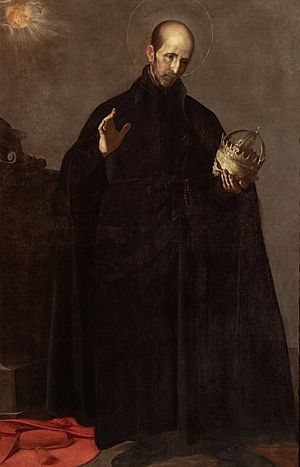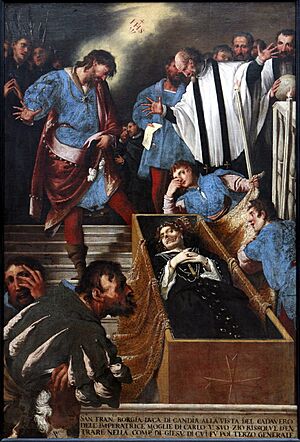Francis Borgia facts for kids
Quick facts for kids SaintFrancis Borgia SJ |
|
|---|---|

Painting by Alonso Cano, 1624
|
|
| Duke of Gandía Confessor Priest |
|
| Born | 28 October 1510 Duchy of Gandia, Kingdom of Valencia, Spain |
| Died | 30 September 1572 (aged 61) Rome, Papal States |
| Venerated in | Catholic Church |
| Beatified | 23 November 1624, Madrid, Kingdom of Spain by Pope Urban VIII |
| Canonized | 20 June 1670, Rome by Pope Clement X |
| Major shrine | Relics translated to the Jesuit church in Madrid, 1901 |
| Feast | 30 September 10 October (1688–1969) 3 October (Jesuits) |
| Attributes | Skull crowned with an emperor's diadem |
| Patronage | Against earthquakes; Portugal; Gandía; Rota, Marianas |
Francis Borgia (born October 28, 1510 – died September 30, 1572) was a Spanish Jesuit priest. He was a great-grandson of Pope Alexander VI. Francis was also the Duke of Gandía and an important noble in Spain.
After his wife passed away, Francis Borgia gave up his noble titles. He then became a priest in the Society of Jesus. Later, he served as the third leader, or superior general, of the Jesuits. He was recognized as a saint on June 20, 1670, by Pope Clement X.
Contents
Early Life and Royal Service
Francis Borgia was born in the Duchy of Gandía. This area was part of the Kingdom of Valencia in Spain. His birth date was October 28, 1510.
His father was Juan Borgia, the 3rd Duke of Gandía. His mother was Juana, daughter of the Archbishop of Zaragoza. As a child, Francis was very religious. He wanted to become a monk.
However, his family sent him to serve at the court of Charles V, Holy Roman Emperor. Charles V was also the King of Spain. Francis was well-liked there and joined the Emperor on many trips.
Adult Life and Family
In September 1529, Francis married Leonor de Castro Mello y Meneses. She was a Portuguese noblewoman. They had eight children together.
Emperor Charles V gave Francis important roles. He was made Marquess of Lombay. He also served as master of the hounds and equerry to the empress.
In 1539, Francis helped transport the body of Empress Isabella. She was the mother of Philip II of Spain. Her body was taken to her burial place in Granada. In the same year, Francis became the Viceroy of Catalonia. He was only 29 years old at the time.
Francis also enjoyed composing music. He created religious pieces. Some historians say he was important in sacred music before Palestrina.
In 1543, Francis's father died. Francis then became the 4th Duke of Gandía. He tried to arrange a marriage between Prince Philip of Spain and a Portuguese princess. This plan did not work out. After this, he retired as duke. He gave his title to his son, Carlos. At 33, he focused more on religious activities.
Becoming a Jesuit Priest
In 1546, Francis's wife, Eleanor, passed away. After her death, Francis decided to join the Society of Jesus. This religious group was quite new at the time. He made sure his children were cared for.
Around 1551, he gave up his noble titles. He became a Jesuit priest. He also helped start what is now the Gregorian University in Rome.
Pope Julius III wanted to make Francis a cardinal. To avoid this, Francis secretly left Rome. He went to the Basque Country. He wanted to spend time in quiet prayer.
However, Francis was also very good at organizing things. His friends convinced him to take on leadership roles. In 1554, he became the Jesuit commissary-general in Spain. He founded many colleges there. After two years, he was chosen for missions in the East and West Indies.
In 1565, Francis was elected the third "Father General" of the Society of Jesus. This was after the death of Diego Laynez.
Leadership and Legacy
From 1565 to 1572, Francis Borgia achieved great success. Historians often call him the greatest General after Saint Ignatius. He founded the Collegium Romanum, which became the Gregorian University. He also gave advice to kings and popes. He carefully managed the growing Jesuit order.
Even as a supreme leader, Francis lived a humble life. During his lifetime, many people already saw him as a saint. Francis Borgia died in 1572.
Death and Sainthood
Francis Borgia died on September 30, 1572, in Rome. His body was brought back to Spain in 1617. His relics were kept in a Jesuit church in Madrid. In 1901, they were moved to another Jesuit church. After that church was destroyed in 1931, some of his ashes were saved. They were later reburied in a new Jesuit complex.
Francis Borgia was declared "blessed" (beatified) in Madrid on November 23, 1624. This was done by Pope Urban VIII. He was declared a saint (canonized) almost 35 years later. Pope Clement X canonized him on June 20, 1670. His feast day is celebrated on September 30.
Many places are named after Saint Francis Borgia. Parishes are dedicated to him in several US states. These include Illinois, Kentucky, Missouri, Nebraska, and Wisconsin. There is also a parish in the Philippines. The city of São Borja in southern Brazil is named after him.
St. Francis Borgia Regional High School is located in Washington, Missouri.
See also
 In Spanish: Francisco de Borja para niños
In Spanish: Francisco de Borja para niños
- House of Borgia
- Route of the Borgias
- Statue of Francis Borgia, Charles Bridge


